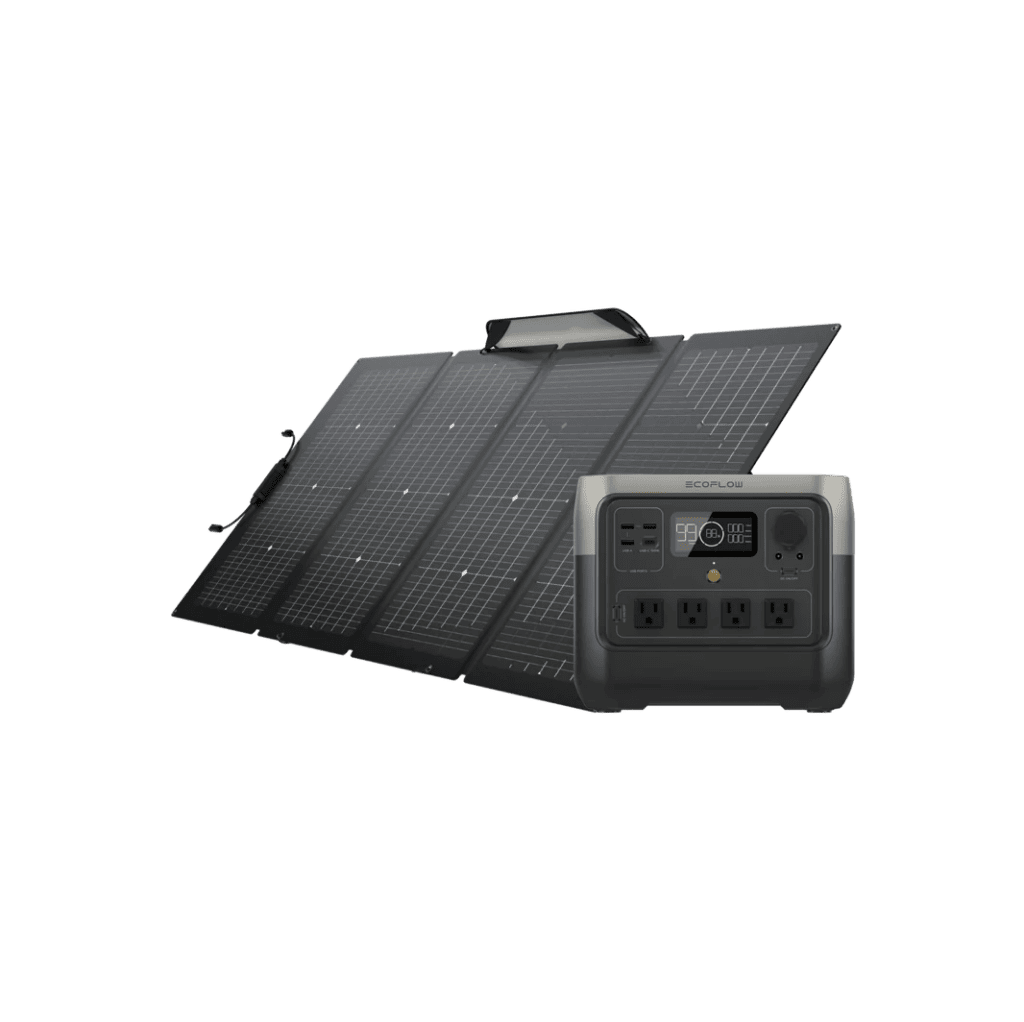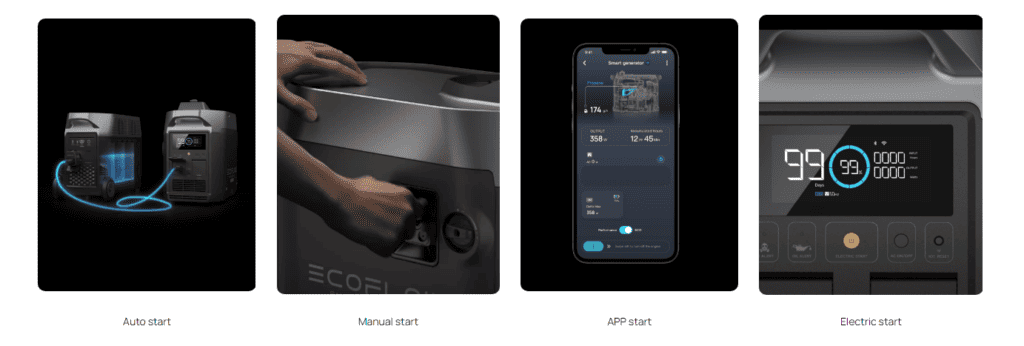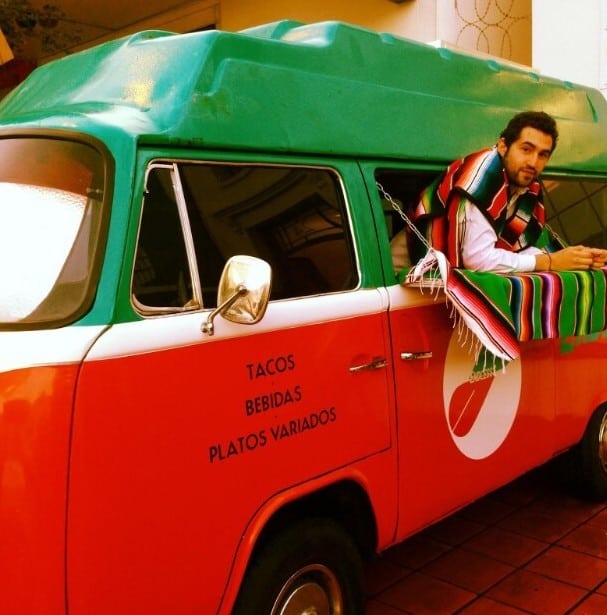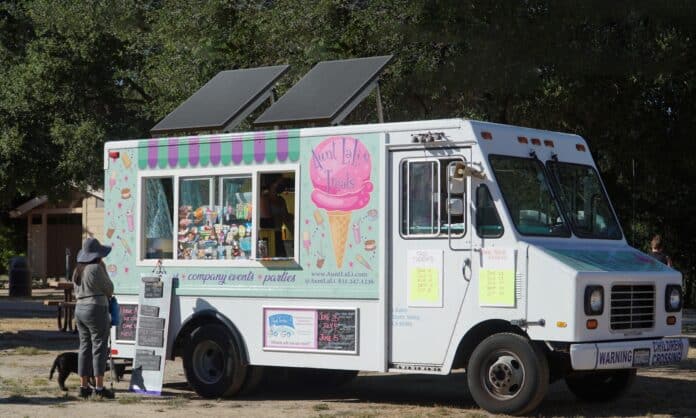Running a successful food truck operation isn’t easy.
Where do you park?
Location, location, location.

Then there are the potential permitting hassles and fines for traffic and food safety violations. Not to mention ensuring the safe supply and storage of perishable items…
And, of course, there’s the question of power.
Unlike brick-and-mortar restaurants, your food truck probably won’t have consistent access to a reliable electricity source.
The best place for your food truck to score the most foot traffic might be in the middle of a park, far from any AC wall outlet. Or at the side of a busy street.
How do you power up all your essential appliances and equipment to keep hungry customers happy during the lunchtime or late-night rush?
Most food trucks rely on butane or propane (LPG) stoves for cooking and reheating. Both butane and propane are inexpensive, easy to store, and relatively environmentally friendly compared to diesel or petrol.
But what about your fridges, microwaves, food processor, blender, deep fryer, air fryer…
You get the point.
That’s where a generator comes in.
The right generator will provide a constant source of clean, renewable — and quiet — electricity wherever you park.
Here are the five best generators for food trucks in 2024.

EcoFlow’s Top Generators for Food Trucks
1. Best for Small Appliances and Electronics: EcoFlow RIVER 2 Pro + 220W Portable Solar Panel
2. Best Entry-Level Generator for All-Day Use: EcoFlow DELTA 2 + 220W Portable Solar Panel
3. Best for Heavy-Duty Appliances: EcoFlow DELTA Pro + 400W Portable Solar Panel
4. Best for Backing Up Your DELTA Pro: EcoFlow Smart Generator Dual Fuel
5. Best for Fully Off-Grid Power: EcoFlow Power Kits
What Are The Different Types of Generators for Food Trucks?
There are numerous types of off-grid generators to choose from, including:
- Petrol
- Diesel
- Propane (LPG)
- Inverter
- Solar
All of the above run solely on fossil fuels — except for solar-powered generators.
The problem with fossil fuel generators for food trucks — especially petrol and diesel — is…
Actually, there are several…
- Fossil fuel generators produce toxic emissions — like carbon monoxide — which can make you, your customers, and your staff sick. Under certain circumstances, carbon monoxide poisoning can be fatal.
- Fossil fuel generators can’t safely operate indoors — or inside a food truck.
- Petrol and diesel generators produce noxious smoke and fumes — not exactly appetising for the potential customers waiting in line or people enjoying their orders.
- Fossil fuel generators produce greenhouse gas emissions that contribute to climate change.
- Diesel and petrol generators are LOUD. Portable petrol generators typically produce 80-100 decibels (dB) of noise — at least 10 dB above the recommended safety threshold. That’s more than loud enough to discourage diners and attract the attention of the authorities. Additionally, many residential neighbourhoods restrict the use of petrol generators due to safety reasons — and the racket they make.
That’s a lot of red flags — and running a profitable food truck is already hard enough.
Good thing you’ve got better options.
Thanks to rapidly improving technology — and falling prices — solar generators are now the most viable option for food trucks.
Not only do solar generators have NONE of the drawbacks of fossil fuel generators listed above, but there are also so many benefits for food truck owners that solar power and mobile food prep are a perfect fit.
- Highly portable
- Can be used indoors — even inside the truck
- Rigid and flexible solar panels are easy to install permanently on the roof and exterior of your food truck
- Portable solar panels can be set up anywhere in a flash and folded down for storage in the truck quickly when you’re done for the day
- Generate clean, renewable electricity anytime there’s sunlight — even if you’re on the go
- No ongoing fuel costs — sunlight is free
- Low-to-no maintenance compared to a petrol genny
- Whisper-quiet operation
- Solar battery storage for nighttime use
And that’s just the tip of the icebox!
Read on to learn more about the five best generators for food trucks in 2024.

1. Best for Small Appliances and Electronics: EcoFlow RIVER 2 Pro + 220W Portable Solar Panel
The RIVER 2 Pro is an ideal solution for the small kitchen appliances you need to prep your food: blenders, food processors, electric coolers, microwaves, toasters etc.
Small enough to fit in any food van or truck, the RIVER 2 Pro can run up to 80% of home appliances.
Use it to power your POS, credit card machine, tablet — and your smartphone.
Gotta keep those Insta snaps and TikToks coming!
You can charge the RIVER 2 Pro from 0-100% in 70 minutes by plugging it into any wall socket before you hit the road. Once you reach your destination, simply unfold the 220W Bifacial Portable Solar Panel and pop it on the roof. Or position it on the ground with included kickstand.
Thanks to its bifacial design and industry-leading 23% conversion rate, the 220W Portable Solar Panel takes advantage of all available sunlight — even on rainy or overcast days.
Speaking of rain, all of EcoFlow’s solar panels are IP68 rated. You don’t need to worry about them getting soggy outdoors, even in harsh weather.
Pros
- Reliable power source for small appliances, credit card machines, POS systems, and personal devices
- Industry-leading conversion rate of up to 23%
- Fast-charging from 0-100% in 70 minutes with AC or 4.5 hours with 220W of solar input
- Recharge the RIVER 2 Pro while it operates by using solar power
Cons
- Not enough power output or storage capacity to run large appliances (like fridges) for extended periods
- Insufficient wattage to run multiple appliances simultaneously
- Limited solar charging capacity (220W max)

2. Best Entry-Level Generator for All-Day Use: EcoFlow DELTA 2 + 220W Portable Solar Panel
With expandable battery storage capacity and up to 500W solar input, DELTA 2 is the newest addition to EcoFlow’s DELTA Series and an affordable workhorse for everyday operations.
Park your food truck at music festivals, county fairs, or outdoor sporting events and enjoy the benefits of clean, renewable solar power all day (and night!) long.
Out of the box, the DELTA 2 has a storage capacity of over 1 kWh and 1800W of operating output (up to 2700W of starting wattage and 2400W of device power using x-boost).
And that’s just to start.
If you add the DELTA 2 Extra Battery, you’ll have over 2 kWh of storage — or purchase the DELTA Max Extra Battery for over 3 kWh of electricity that you can use day or night.
With that much power, you can operate your fridges, fryer, and warming station for hours.
The DELTA 2’s LiFePO4 solar battery boasts exceptional longevity. It can fully charge and discharge for up to 3000 cycles before dropping to 80+% of its original capacity. That reduction in capacity doesn’t mean the portable power station will stop working, but you won’t be able to go as long between charges.
The DELTA 2 is an excellent long-term investment in your food truck’s success.
Pros
- Expandable capacity up to 3kWH
- Well-suited for all-day operations
- Industry-leading recharge times and lifespan
Cons
- Depending on how much electricity you consume, for how long, at the same time, the DELTA 2 might not meet your requirements

3. Best for Heavy-Duty Appliances: EcoFlow DELTA Pro + 400W Portable Solar Panel
If you’re cooking with gas, some food trucks can get by with just enough electricity for small appliances — like blenders, food processors, a bar fridge, and a microwave.
But if your food truck relies on electricity for a grill, stove, commercial refrigerators, an oven, or air conditioning, you’re going to need a more robust off-grid power solution. Especially if you use any or all of them at the same time.
The DELTA Pro has a 3600W AC output (up to 7200W of starting wattage and 4500W of device power using x-boost), meaning you can power any appliance a food truck could ever need.
Still not enough power to run all your appliances simultaneously? Double up your output, storage, and solar input capacity by chaining two units together using EcoFlow’s Double Voltage Hub.
Out of the box, the DELTA Pro offers 1,600W of solar charging capacity, meaning you can connect up to four 400W rigid or portable solar panels to meet your off-grid electricity needs. As with power output and storage, you can double your generation capacity by adding a second DELTA Pro, giving you 3,600W solar input (8 x 400W solar panels).
With 4 x 400W rigid and/or portable solar panels connected, DELTA Pro can generate up to 11.2kWh per day in the right environmental conditions.
The DELTA Pro offers more wattage and expandability than any other portable power station. Add solar panels, and it’s the ultimate portable solar solution for food trucks on the market.
The DELTA Pro also recharges quickly – from 0-100% in under 2 hours with AC electricity when your food truck is on-grid. Depending on how many 400W solar panels you connect — and the available sunlight — the DELTA Pro can recharge in as little as 3.5 to 5 hours.
The DELTA Pro is the perfect compact solution for running multiple high-wattage appliances simultaneously and helps ensure you have enough off-grid electricity for high-volume rushes.
Pros
- A powerhouse of off-grid electricity generation capacity, DELTA Pro can produce up to 11.2kWh daily (depending on environmental conditions and the number of solar panels).
- After you purchase the DELTA Pro, your solar-generated electricity is free. With zero ongoing fuel costs, the DELTA Pro is a much better investment in your food truck — and the planet — than a traditional petrol-guzzling genny.
- Offers energy independence
- Perfect for running multiple high-wattage appliances simultaneously to keep you out of the weeds during a rush
Cons
- The DELTA Pro is portable, but it’s not light. At 99 lbs (45kg), lifting it in and out of your truck can be an effort. Once it’s on the ground, it’s got built-in wheels (like a suitcase), but it’s worth noting that heavyweight power comes with a heavier build.
- Similarly, the DELTA Pro is MUCH bigger than the RIVER 2 Pro. At 25 x 11.2 x 16.4 inches (63.5 x 28.4 42 cm), its footprint can be significant in a small food truck.
- If you only use smaller appliances — or you use large appliances but not simultaneously — DELTA Pro might offer more power than you need. Carefully calculate your electricity requirements and invest in the off-grid power solution that meets your needs.

4. Best for Backing Up Your DELTA Pro: EcoFlow Smart Generator Dual Fuel
The higher your portable power station’s solar input capacity, the more solar panels you can add — and the more clean, renewable electricity you can generate.
However, solar is not without its limitations. You can’t generate electricity after dark, and you’ll produce less on overcast or rainy days. That’s why having adequate storage capacity with a solar battery (built-in with EcoFlow Portable Power Stations) is essential for off-grid power solutions.
Using a DELTA Pro with multiple 400W solar panels should provide you with more power than your food truck will ever need before requiring a recharge.
However, if you’re taking your food truck off-grid for extended periods — say to a multi-day music festival — the last thing you need is to run out of power at the wrong time.
That’s where the Smart Generator Dual Fuel comes in. Think of it as a last line of defence against ever being stuck without power when you could be making money.
The Smart Generator Dual Fuel runs on petrol or propane (LPG) and integrates seamlessly with EcoFLow’s DELTA 2, DELTA Max, and DELTA Pro.
When your battery dips below a set level (that you can determine), the Smart Generator Dual Fuel kicks in automatically. That is, if you want it to…

With four different starting methods…
- You can opt for Auto Start (when using DELTA Max or DELTA Pro)
- Let it rip old school style with the Manual Start
- Control and start your Smart Generator Dual Fuel using the EcoFlow smartphone app from anywhere with internet access
- Press the orange button for an instantaneous Electric Start
Unlike the other solar generators reviewed here, the Smart Generator Dual Fuel runs on fossil fuels. You CAN use it standalone — but that’s not its best application. If solar lets you down for any reason, the Smart Generator Dual Fuel is the ideal emergency backup.

The Smart Generator Dual Fuel does share some of the disadvantages of traditional fossil fuel generators. However, when used to recharge a DELTA Pro or Max, it will burn significantly less fuel.
Combining the Dual Fuel generator with a DELTA Pro or Max portable power station gives you an immediate 40% efficiency gain, produces fewer harmful emissions, and charges your solar batteries — all at the same time.
You have the option to use unleaded petrol for fuel — which can be useful in a pinch. A better option is to run the Smart Generator Dual Fuel with propane (LPG). LPG is easier to store, has a longer shelf life, and burns much cleaner. And you may already be using it for your gas grill or range.
With 1600 – 1800W of electrical output, you can generate 5.4kWh on a full tank of petrol (4L) and up to 20 kWh of power on a standard canister of propane.
EcoFlow’s Smart Generator Dual Fuel adds another layer of reliability to your off-grid power solution.
Pros
- Produces 90% less carbon monoxide than traditional petrol generators
- Can run entirely on cleaner, easier-to-store propane (LPG)
- 4L petrol tank gives you yet another backup fuel option
- Makes less noise than other fuel generators
Cons
- Outdoor use only; not safe to run fuel generators indoors
- Less environmental impact than traditional fossil fuel generators — but not 100% clean or renewable like solar
Specs
- Net weight: 67.2 lbs (30.5kg)
- Size: 23.5 x 11.8 x 18.7 in (59.7 x 30.0 x 47.5 cm)
- Type: Inverter Generator
- Frequency: 60Hz
- Rated Voltage: 120 volts
- Rated Power (Petrol): 1800 watts (Peak 1900 watts)
- Rated Power (LPG): 1600 watts (Peak 1700 watts)

5. Best for Fully Off-Grid Power: EcoFlow Power Kits
If you plan on operating your food truck off-grid most or all of the time, EcoFlow’s modular Power Kits could be your ideal solution.
Power Kits are designed for fixed installation in food trucks, motorhomes, and vans. They’re not the right choice if you only occasionally use off-grid electricity.
If you want to run a successful food truck 100% off-grid, there’s no better choice.
Power Kits are modular, compact, and highly customisable. Use the online calculator to see what build is right for you.

With electricity storage options of 2 kWh all the way up to 15 kWh, AC Main output of 3600W (Surge 7200W), and DC Main Output of 1600W, you can power anything you’ll ever need to operate your food truck.

Power Kits offer up to 4,800W of solar charge capacity. Depending on your food truck’s available surface area, you could install up to 12 x 400W solar panels.
Or you can combine 400W portable or rigid solar panels with 100W flexible solar panels to maximise every inch of space.

Flexible solar panels are perfect for installation on the irregular or curved surfaces commonly found on food trucks.
Power Kits offer four charging options. Aside from solar, you can recharge using shore power, your food truck’s alternator, and the Smart Generator Dual Fuel.
As with the DELTA Pro and Max, the Smart Generator Dual Fuel offers an additional backup power option. But given the Power Kit’s storage and electricity generation capacity, it’s doubtful you’ll need it.
Pros
- 100% off-grid power
- Simple DIY assembly
- Compact build for virtually any size of food truck
- Save valuable space with stackable batteries
- Customisable battery storage capacity for any size food truck
- Generate power on the move — any time day or night. Use rooftop solar panels to charge during sunlight hours and your vehicle’s alternator to charge after dark
Cons
- Expensive
- Could be more powerful than you need for a food truck

What To Consider When Choosing a Food Truck Generator
Every food truck is different.
Determining how much electricity you’ll consume off-grid should be the most crucial consideration when purchasing a generator for your food truck.
But it’s not the only factor.
Don’t make a purchase decision you’ll regret…
Check off every point on this list.
Power Output
Next to your total electricity consumption, figuring out how much simultaneous power output you need is the most crucial factor to consider.
To ensure adequate electricity output, tally up the starting and running wattage of every device or appliance you need the generator to run simultaneously.
Here’s how you do it.
- Identify the wattage requirements of your appliances. Survey the starting and running wattage requirements of the appliances and devices you plan to plug into the generator. You can usually find the wattage requirements labelled on the appliance. But to give you a rough idea, we’ve also compiled the starting and running watts of typical household appliances in the table below.
- Convert volts/amps to watts. If your appliance’s power requirements are in volts or amps, you can calculate an appliance’s running watts with this equation:
Volts (V) x Amps (A) = Watts (W)
- Count the running watts of your appliances. Add up the running watts of the appliances you plan to use — does the total exceed the running watts listed on your generator? If so, consider buying a generator with more output capacity.
- Factor in starting watt requirements. Identify the appliance with the highest starting wattage. Add that appliance’s starting wattage to the running wattage total.
- Calculate the sum. That final number is the total starting watts you need from your generator. As discussed above, to avoid overloading your generator, do not exceed its starting watts rating.
Starting and Running Watts of Typical Food Truck Appliances (Estimates Only)
| Appliance | Rated (Running) Watts | Starting Watts |
| Home Refrigerator/Freezer | 700 | 2200 |
| Light Bulb | 60-75 | 0 |
| Microwave | 600-1000 | 0 |
| Toaster | 900 | 0 |
| Coffee Maker | 1000 | 0 |
| Blender | 300 | 800 |
| Toaster Oven | 1200 | 0 |
| Space Heater | 2000 | 0 |
| Laptop | 50-300 | 0 |
| 20” Box Fan | 200 | 350 |
Once you know your electricity consumption requirements, invest in a generator with at least 10% more power output than you need.
Additional output gives you room to grow and leaves you a margin of error.
Run Time
This is a tricky one, because there are so many factors at play.
Start by estimating the amount of time you want to operate off-grid. Be safe and multiply the total operating wattage of all your appliances and multiply it by the number of hours you’ll be using the generator.
Total Wattage (W/kW) x Hours Off-Grid = wH/kWh
So, if you plan on running 3,000 watts of appliances for 8 hours a day, the total kWh of storage + electricity generated you’ll need is 24kWh.
3,000W x 8 hours = 24 kWh (Electricity Storage + Electricity Generation)
If you have a fully-charged portable power station configuration that provides at least 24kWh (+10%) of storage, you should be able to operate at total capacity for 8 hours without interruption.
The likelihood of you needing to run all your appliances simultaneously for 8 hours is probably zero. But it’s a good starting point to work from. If the kWh of electricity you require is much lower 24kWh, then this calculation could be all you need.
If not, calculate a more realistic estimate of your electricity consumption.
An off-grid power solution that stores 24 kWh of electricity is a substantial investment.
Using EcoFlow products as an example, you’d need to purchase 2 x DELTA Pros, 2 x DELTA Pro Extra Smart Batteries, and a Smart Generator Dual Fuel to reliably achieve 25 kWh without recharging or electricity generation.
That’s where solar panels come in. Portable power stations can store power, but they can’t generate it.
A portable power station only becomes a solar generator when you add solar panels.
Electricity Generation Capacity
You can fully charge portable power stations or Power Kits in a few hours (or less) using AC electricity.
Before you pull out of the garage each day, plugging into grid power helps ensure you have enough electricity to beat the morning rush — or the lunch or evening rush, depending on when you start serving.
If you’re using solar panels to generate all or some of your electricity, be sure to check that the solar charging input of your PPS or Power Kit is sufficient to meet your electricity generation requirements.
For example:
- DELTA Max offers a maximum 800W of solar input capacity (2 x 400W solar panels)
- DELTA Pro offers a 1600W of solar input capacity (4 x 400W solar panels)
- 2 x Delta Pros chained together with a Dual Voltage Hub deliver up to 3200W of solar charging capacity (8 x 400W solar panels)
- Power Kits offer up to 4800W of solar input capacity (12 x 400W solar panels)
As long as you don’t exceed the maximum solar charge input, you can mix and match EcoFlow’s portable, rigid, and flexible solar panels to build the ultimate off-grid solution for your food truck.
DELTA Max, DELTA Pro, and Power Kits integrate seamlessly with the Smart Generator reviewed above. Having the option to switch to propane/petrol to recharge your PPS or Power Kit gives you additional energy security.
“Running out of food” can be a valuable marketing tool for building demand and buzz for your food truck…
But you’ll never want to disappoint customers — and kill your margins — because you’ve run out of electricity.
With the right off-grid power solution, you’ll never have to.
Lifespan
“Cycle life” is the metric typically used to estimate the lifespan of a battery.
Batteries are essential components of off-grid solar generators, and most manufacturers will give you an estimate of the battery’s cycle life.
Basically…
1 x cycle = 1 full discharge/recharge of the battery
Unlike lead acid batteries, lithium-ion batteries aren’t much impacted by time. How much you use Li-on batteries determines how long they’ll last.
Quality Li-on batteries will always have a longer cycle life than lead acid or nickel-cadmium (Ni-Cad) batteries.
LiFePO4 batteries — a newer subset of Li-On — last even longer! You’ll find LiFePO4 (LFP) batteries in all of EcoFlow’s current range of portable power stations and Power Kits – except for the DELTA Max.
Let’s take a look at the difference solar battery chemistry has on lifespan.
- Average lead acid battery: 500-800 cycles
- DELTA Max Portable Power Station (Ni-Cad): 500 cycles to 80% capacity
- DELTA Pro (LiFePO4): 6,500 cycles to 50% capacity, 3,500 cycles to 80% capacity
- Power Kits (LiFePO4): 6,000 cycles to 50% capacity, 3,000 cycles to 80% capacity
The DELTA Pro and Power Kits are the clear winner when it comes to lifespan.
With everyday use, lead acid and ni-cad batteries might last you a year (or less) before a significant dip in performance.
You can expect EcoFlow’s LiFePO4 batteries to last for at least five years of heavy, daily use — or much longer, depending on your consumption patterns.
Portability vs Permanent Installation
Except for the Power Kits, all of the power generators on this list are portable. Even the DELTA Pro weighing 99 lbs (45kg), has built-in wheels and is relatively easy to move from place to place.
Portable power stations can generate a significant amount of electricity for your food truck with the advantage of being easy to set up anywhere. If you’d rather not commit to fixed installation on your truck, a portable power station is the way to go.
A PPS is also a more affordable option if you’re just starting up your food truck business, you’re on a tight budget, and you need to hit break-even quickly.
For established food truck owners, Power Kits offer a permanent off-grid power solution that can meet all your electricity needs.
A fixed, rigid solar panel installation may not be portable, but it is mobile. Unlike portable solar panels, rigid and flexible PV panels generate electricity even when you’re driving — as long as there’s sunlight.
You can also use your food truck’s alternator to generate up to 1000W of electricity for each hour you’re on the move.
Like The Verge said, “EcoFlow’s Power Kits are a game-changing all-in-one power system… that makes off-grid living easy.”
The same holds true for food trucks!

Noise
Noise is a big deal when selecting a generator for your food truck. The noise from a petrol or diesel generator can be a nuisance at best. At worst, it can prevent you from trading altogether.
The average petrol or diesel generator produces 80-100 decibels (dB) of noise — comparable to the “inside of an aeroplane or an approaching subway train.”
That doesn’t even take into account the effect a petrol generator’s roar and toxic emissions will have on your customers’ appetite.
By contrast, solar generators are emission and virtually noise-free.
If it weren’t for the solar panels, people wouldn’t even know it’s there.
EPA Compliance
The Office of Air and Radiation (OAR) within the EPA limits the level and type of emissions that portable and commercial-grade generators can legally produce.
If you opt for fossil fuel, ensure that the generator you purchase is EPA-approved, not just for the health of you and your customers — but for the health of the planet.
Renewable sources of electricity like wind and solar are on the rise compared with natural gas and coal.
The reason for this is simple: renewable energy is cleaner, healthier — and less costly in the long run for you and the environment.
By choosing a solar generator over a fossil fuel option, you can reduce your food truck’s carbon footprint and help limit toxic emissions…
And you can use the electricity stored in your PPS or Power Kit indoors!

FAQs
What Generator Size Do I Need To Power a Food Truck?
Choosing a generator that meets your food truck’s electricity requirements depends on your energy consumption needs. To ensure sufficient electricity output and storage capacity, add up the total running and starting wattage (W/kW) of the appliances you wish to run simultaneously. The power output of your generator should exceed the total wattage by at least 10%.
To determine your electricity storage needs, estimate the run time you’ll need from each appliance while off-grid. For example, the average blender requires 300W of electricity per hour. But unless you’re serving frozen margaritas, you’ll probably only run it for 2 hours a day max.
In that case, the amount of electricity the blender will consume is 600Wh per day. (300W x 2 hours = 600Wh).
The above calculations apply whether you opt for fossil fuel or solar. Solar generator manufacturers measure battery storage capacity in wH/kWh. Fossil fuel generator manufacturers estimate how many kWh of electricity you can get using a full tank of petrol.
Can You Run a Food Truck Using a Generator?
You can supply all of your food truck’s electricity requirements using a generator, but you can’t drive the vehicle itself — yet! With Electric Vehicle (EV) adoption booming and technology rapidly improving, EV food trucks are already on the market. 2 x DELTA Pro Portable Power Stations (fully charged) can provide a 7.2 kWh of electricity for an EV using the proper adapter. In a compact passenger EV, that might get you to the nearest charging station — 20-30 miles (30-50km). But a solar generator is not currently practical as the sole charging option for an EV big enough to operate as a food truck.
Are Food Truck Generators Worth It?
If you’re going to operate your food truck off-grid, NOT having a generator isn’t really an option. Sure, you can cook with gas. You can even keep things cool with a propane-powered fridge. But realistically, you’ll need electricity — whether for appliances like microwaves, blenders, toasters, food processors; lighting; or even your sound system. What’s a food truck without music?
Over the long term, solar generators are a better investment than fossil fuel as there are no ongoing fuel costs.
Suppose you have constant, reliable access to electricity for your food truck through AC or shore power and only occasionally go off-grid. In that case, you may not need a generator at all.

Conclusion
Solar is the fastest-growing electricity generation source for a reason.
Actually, many reasons
- Rising demand and adoption
- Rapidly improving technology
- Sharply falling prices
- Government incentives
- Renewable, clean energy that’s better for the planet
Just a few years ago, a solar generator wouldn’t have been a realistic (or affordable) option for your food truck business.
Thanks to innovators like EcoFlow, that’s changed — for the better!
Make the right long-term investment for your food truck’s off-grid electricity needs.
Check out EcoFlow’s best generators for food trucks today!


